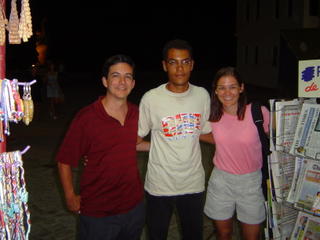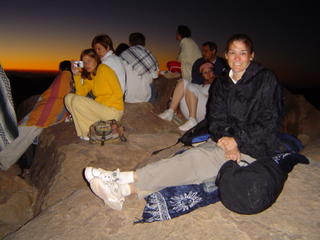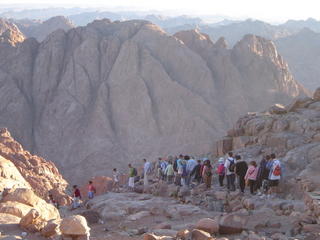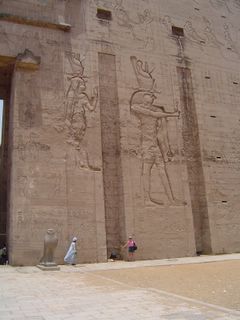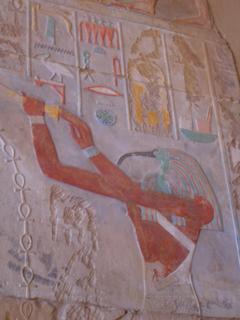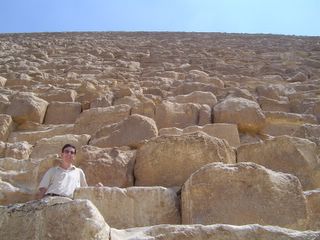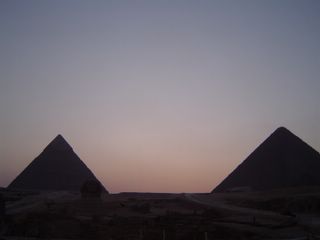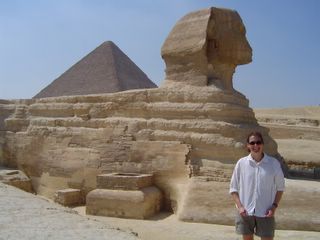What is the proper reaction to a terrorist attack in a foreign country, when you just happen to be traveling in that country on the day the bombs explode? Should you leave immediately? Or, if you decide to stay, is it even possible to go on with your trip as if nothing happened?
Lisa and I, along with thousands of other travelers, were faced with those questions in the aftermath of the terrorist bombings at Sharm El Sheikh, Egypt. We were in a different city when the attacks happened and were not in any danger from those particular incidents, but it’s nevertheless an odd and unsettling feeling to know that the bombs were specifically targeted at a tourist resort in a country where we were tourists.
On the day of the bombings, we were in Luxor. That morning, after breakfast, we went out to meet the guide who would take us to Karnak Temple. When we saw Mohammed, though, he immediately said to us: “Did you see the news? There was a terrorist bombing during the night in Sharm El Sheikh. Three bombs. More than 60 people killed.”
It’s always shocking to hear news of any such attack. Even when we are not in London or Madrid or Bali or New York, it’s impossible to not be moved by the tragedy and appalled by the senselessness of the violence. But not only were Lisa and I in Egypt when this happened, we also happened to be on our way to the Sinai peninsula the very next day. In fact, as recently as four days earlier we’d been debating whether to go to Sharm El Sheikh or Dahab, two contrasting tourist towns on the Red Sea coast.
So there we were, standing alongside the Nile River, about to visit Karnak, the greatest temple complex of ancient Egypt, and our guide was telling us there had been a terrorist attack during the night in another region of the country. We looked around at the street and the river. Nothing seemed any different. If we hadn’t been told this news, it would have appeared like any other day. But we
had heard the news, and that changed everything.
“It is very tragic,” said Mohammed, “but you should go on with the tour. There is more security here today, it will be very safe. It would be sad to miss Karnak. You should focus on the moment.”
We decided to listen to him and so for the next few hours we toured Karnak Temple. As the morning wore on, though, and the desert sun grew more intense overhead, Mohammed opened up a bit and grew more introspective.
“This is not a war against the West,” he said to us, “this is a war against humankind. These are the worst kind of Muslims who do these acts. They are using their religion for bad aims. In Egypt, we believe in a tolerant Islam. I don’t know what kind of people can do this, to kill people like this!”
At another moment, he swept his arm around. “Look at all of these boats on the river. They may all be empty soon, if tourists don’t come to Egypt. And these merchants, and taxi drivers and restaurants. So many people rely on tourism to make a living. It is sad.”
“Do you think there may be another attack,” asked Lisa. “Are you afraid? Is it dangerous?
“Ah, what is dangerous?” whispered Mohammed. “You can have danger in your home or crossing the street. You must live your life, I think.”
That is the very question we had to ask ourselves, of course. And soon. What is dangerous? There had been a terrorist attack aimed at tourists. Was it safe to remain in Egypt, or was it crazy? Should we live our lives, or should we flee? News reports later indicated that perhaps half the tourists in Egypt did leave in the day or two after the bombings. But a sizeable number also chose to remain in the country. Some of them just assumed there wouldn’t be a second attack; others refused to give in to the terror (like the woman we met on the train later that evening who said, “I don’t like to be bullied by terrorists”); and some were just hardened to terrorism in general after a string of attacks in all parts of the world (“where you can consider yourself safe now, anyway?” was a question that we heard often in the days ahead).
As Lisa and I discussed the situation, we knew that our options were limited a bit by the fact that we weren’t scheduled to fly out of Cairo. Our plans were to go to the Sinai, then travel overland to Jordan and finally fly out of Amman. We of course always had the option of spending money to purchase a new ticket, but it was less easy to change our existing itinerary. We naturally wanted to be smart and safe, but we also knew by now that there had been a second attempt to terrorize London and so we couldn’t be certain anymore that we’d be safer in Europe than in Egypt. Actually, the only thing we knew for sure was that certainty was out the window.
In the end, after much discussion, we decided to stay. I’d like to say that it was a heroic decision, that we wanted to live our lives and not be bullied, and, yes, we certainly carried some of that sentiment inside. But we still would have put our safety first had we felt seriously threatened. There was no single reason for our decision, but rather a web of interconnected reasons. For one, we didn’t feel unsafe among the Egyptians, who had been friendly and welcoming to us. We knew there was always the threat of another attack, but we also knew the odds were no better here than somewhere in Europe or the U.S. And we had checked into various transport options and realized it was actually easier for us to go forward with our itinerary than to go back and try to change our plans. So we stayed in Egypt.
We were far from alone in this decision. There were many other tourists around, although the numbers had dropped significantly and the businesspeople who relied on the tourist trade were despairing. In their anguish, however, some of them opened up and spoke with us in a way that they might never have otherwise.
“Foolish people, those terrorists!” said one merchant to us. “Why kill? Why? It is crazy!”
“You are Christian, I am Muslim,” said another person. “But we both have blood, we are both human beings. This is not Islam, to kill like this.”
To be honest, it was easy for Lisa and me to feel a bit self conscious when we first heard the news about the bombings. After all, we are citizens of a country that has enraged many Muslims with its policies, particularly the decision to go to war in Iraq. It would be easy, we thought, for the Egyptians to be furious with America and Americans. But that is not what we discovered.
“Look,” said one person, “it is true that we don’t like Bush. Or Cheney. Or maybe Condoleeza or Rumsfeld. And we don’t like decision to go to war in Iraq. But American people we like. People are not government. We know there is a difference.”
“We like American people,” was a constant refrain from individuals with whom we spoke. “Americans are very welcome in our country.”
In the end, we were safe and were glad that we stayed in Egypt. We had some great experiences during the following week-and-a-half and had some conversations with locals that might not have been possible under normal circumstances. It’s a small gift, but we’ll take it. As Mohammed told us in Luxor, we need to focus on the moment and live our life. That may have been the best lesson from our entire trip.







